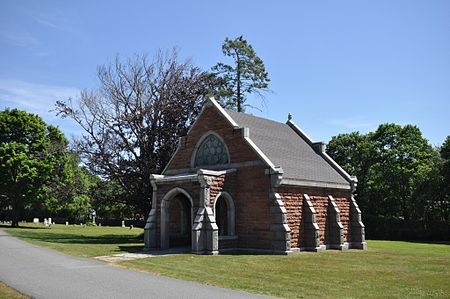Oak Grove Cemetery (New Bedford, Massachusetts)

The Oak Grove Cemetery is a historic cemetery on Parker Street in New Bedford, Massachusetts. It consists of two parcels, separated by Parker Street, northwest of the city's central business district. The older portion of the cemetery, that south of Parker Street, was established in 1843, while the northern section was acquired and developed between 1870 and 1896. Most of the cemetery is laid out in the then-fashionable rural cemetery style of winding lanes, although the northernmost section has a more open layout, made partly due to complaints about the cluttered nature of the rural cemetery style.The cemetery was listed on the National Register of Historic Places in 2014.
Excerpt from the Wikipedia article Oak Grove Cemetery (New Bedford, Massachusetts) (License: CC BY-SA 3.0, Authors, Images).Oak Grove Cemetery (New Bedford, Massachusetts)
Parker Street, New Bedford
Geographical coordinates (GPS) Address Nearby Places Show on map
Geographical coordinates (GPS)
| Latitude | Longitude |
|---|---|
| N 41.6437 ° | E -70.942 ° |
Address
Parker Street 175
02740 New Bedford
Massachusetts, United States
Open on Google Maps







